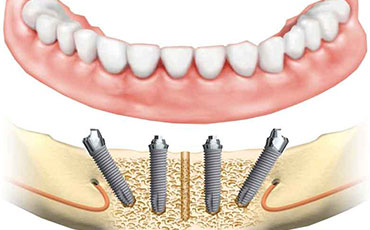All On 4 Dental Implants
 The All on 4 implants system was invented by Dr. Paulo Malo in the 80’s. The system is based on principles regarding dental implants that were accepted as far back as the 60’s, and Dr. Malo evaluated these and determined a clear, comfortable work protocol. Today, there are many improvements to Dr. Malo’s original protocol. The system is based on fastening 4 implants in very specific locations to create a three dimensional trapezoid force that enables the attachment of bolted dentures or a bolted bridge containing 12 teeth. Very careful planning is required, broad surgical experience, and the rehabilitation must be performed very exactly so that implants and rehabilitation can be done on the same day. The vast experience we have amassed at our clinic ensures uncompromising quality and reliability.
The All on 4 implants system was invented by Dr. Paulo Malo in the 80’s. The system is based on principles regarding dental implants that were accepted as far back as the 60’s, and Dr. Malo evaluated these and determined a clear, comfortable work protocol. Today, there are many improvements to Dr. Malo’s original protocol. The system is based on fastening 4 implants in very specific locations to create a three dimensional trapezoid force that enables the attachment of bolted dentures or a bolted bridge containing 12 teeth. Very careful planning is required, broad surgical experience, and the rehabilitation must be performed very exactly so that implants and rehabilitation can be done on the same day. The vast experience we have amassed at our clinic ensures uncompromising quality and reliability.
As a rule, this method is meant for jaws that are lacking all of the teeth (for patients with complete dentures or in which all of the teeth must be extracted). Sometimes, if only one side of the jaw is missing teeth, this method can be used only on that side. In cases when initial bone matter is insufficient in quantity or quality, the rehabilitation can be done with 6 implants (instead of 4) to better distribute the pressure between the points.
The Benefits of the “All on 4-6” Method:
• Immediate loading of the implants – within a few hours, a previously toothless patient can chew.• Suitable for very busy people or people suffering from dental anxiety.
• Minimization of surgical procedures and treatment time – recuperation time is lessened and usually, sinus lift procedures and the like are not necessary.
• The implants can usually be inserted at the same time that the corroded teeth are being extracted – in other words, extraction, implantation, and returning to a functioning mouth in just one day!
• TEETH IN A DAY.
• Significantly less expensive than other permanent rehabilitation solutions.
The Disadvantages of the “All on 4” Method:
• Not appropriate for every patient – significant health issues can interfere with the treatment. Cannot be performed by most dentists, since it requires very careful planning, especially high surgical capability, extensive rehabilitative experience.• Two dentists are needed, who must be working at the same clinic.
• Because of the complexity of the procedure, it cannot be optimally performed by just one dentist.
• Sufficient quantity and quality of initial bone is necessary.
Permanent Full-Mouth Rehabilitation in Just Half a Day